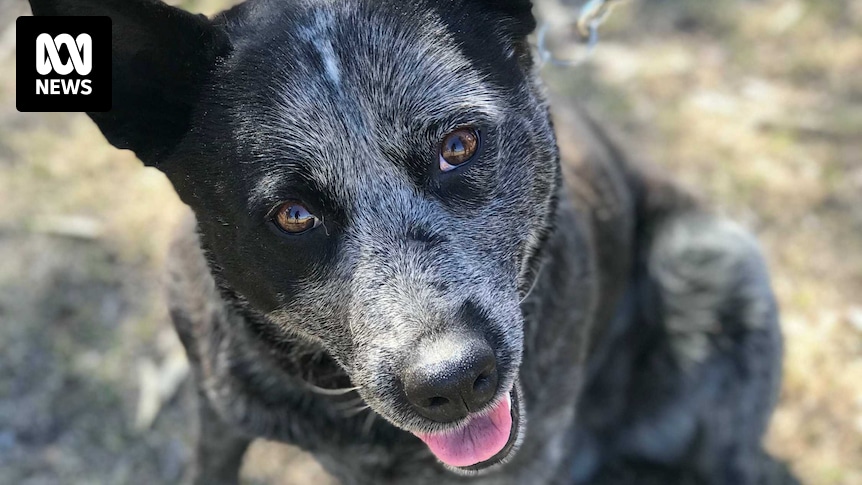The origins of the blue heeler are mired in myth and mystery. Some websites even claim that the breed is descended from six breeds, including the Dalmatian, but a new book hopes at last to set the record straight.
Author Guy Hull, who calls himself a dog behaviouralist, has had a lifelong interest in the contribution of canines to the nation’s development, hence his book title, The Dogs that Made Australia.
The blue heeler, now officially called the Australian cattle dog, was the first successful Australian dog breed.
Bred to work cattle, they were much needed. In the 1820s, the existing cattle dogs of English descent were struggling to tame the wild bush beasts of the new colony.
“They were only used to working quiet, domesticated cattle over relatively short distances,” Hull said.
“They bring them to Australia, it’s flint hard, it’s dry most of the time and they were dealing with wild and semi-wild cattle, horned beasts that were quite independent.”
In 1825 at Dartbrook Station in the rolling hills of the upper Hunter Valley of New South Wales, Thomas Simpson Hall crossed an English drover’s cur with a dingo.
Hall was part of a family dynasty with a spread of properties from western Queensland almost all the way to Sydney and a beef empire that at its peak had about 60,000 head.
He had his own team of drovers and issued them with his new, highly-prized breed of dogs, dubbed Hall’s heelers because of their ability to shift stock by nipping at the heels of recalcitrant cattle to harry them along.
Shadow is part of the lesser known strain of heelers. (ABC News: Tim Lee)
Hall must have been an exceptional dog breeder. Somehow, he incorporated a dingo into a line of specially imported blue-coloured dogs sent to him by his relatives in northern England.
Through repeated backcrossing, by 1832 he had developed a highly useful cattle dog.
The Hall’s heeler had all the toughness and stamina of the dingo combined with the stock sense and instinct of the cur.
It’s believed to be the only instance in the world where a wild dog has been bred with a domestic dog to achieve a biddable working offspring.
We’ll never know how Hall went about it because after his death in 1870, his meticulous breeding records were dumped down a well.
Uncovering the cattle dog’s hidden past
Yet Hull found a rich source of verifiable detail from 91-year-old historian Bert Howard, whose late wife Beryl was a descendant of the Hall family.
Years ago, while researching her family’s history, Mr Howard began piecing together the story of the mysterious breed.
His detailed research in England confirmed Hall had imported drover’s curs from Northumbria and that they were a bob-tailed type with a blue coat.
“He started his program in 1825 and it was 1832 when he was quite satisfied with the cross he achieved,” he said.
“We don’t know how many backcrosses he did.”
The mating of this dog with a dingo meant that pups could be either red or blue in colour, a trait that endures to this day.
Some had the bob tail of the cur, while others inherited the brush tail of the dingo.
The red-coated cattle dog is believed to be a throwback to its dingo ancestry. (ABC News: Tim Lee)
Heelers also possess an unusual double coat, a tough long-haired outer coat and a shorter fine inner coat — also a relic of dingo ancestry.
Several decades after Hall developed his heeler, an offshoot of the breed arose called a Timmins’ biter, named after the stockman who developed the strain.
It was a dog with a bob tail, usually blue in colour and the progenitor of a line of heelers today known as stumpy tails.
They differ slighter from their cousins, being leaner in build and less gregarious in nature.
Hull’s motivation to write his book was partly prompted by an earlier best-seller called Barkers and Biters, published early last century.
Its author, influential journalist and self-appointed dog expert Robert Kaleski of Sydney, took a shine to Hall’s heelers, but his writings were largely inaccurate and Kaleski was a big-noter.
He even claimed to have developed the blue heeler breed.
“Now we’d always been told by Australia’s great dog authority of the late 19th and early 20th century, Robert Kaleski, that it was a cross between a dingo and a collie,” Hull said.
“There is no collie in the original breed.”
But Kaleski did bestow the title of Australian cattle dog on the brush-tailed strain of the breed and that name is now the accepted one.
In recent times, it has become very popular as a pet, while its tailless cousin has fallen a little out of fashion.
Cattle dogs — with or without a tail — are still greatly valued by cattlemen and women for their unique stock working abilities.
Hull hopes he has at last cleared up some of the confusion over this uniquely Australian but often misunderstood breed of dog.
Three stumpy-tailed heelers enjoy a frolic in the Colo River, north-west of Sydney. (ABC News: Tim Lee )
Tim Lee’s Landline story Tale of Two Tails can be viewed on ABC iView.


